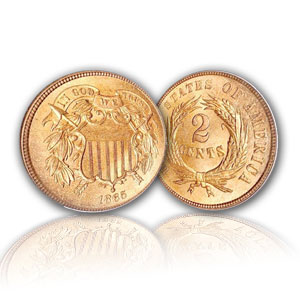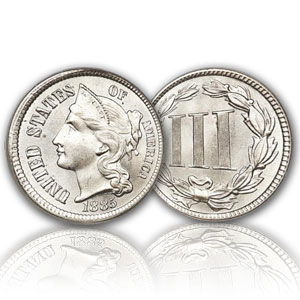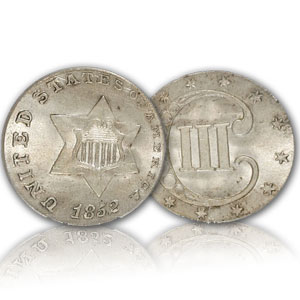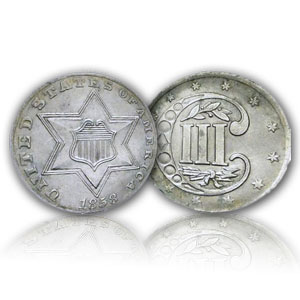The two-cent piece was produced by the Mint of the United States for circulation from 1864 to 1872 and for collectors in 1873. Designed by James B. Longacre, there were decreasing mintages each year, as other minor coins such as the nickel proved more popular. It was abolished by the Mint Act of 1873.

The United States three cent piece was a unit of currency equaling 3⁄100 of a United States dollar. The mint produced two different three-cent coins: the three-cent silver and the three-cent nickel. During the period from 1865 to 1873, both coins were minted, albeit in very small quantities for the silver three cent piece.

The Three Cents (Nickel) piece was immediately popular, due to its large circulation in 1865 and its usefulness in replacing fractional currency.
The Nickel 3-Cent piece was our nation’s second type of 3-cent coin. But the appearance of the Nickel 3-Cent piece in 1865 didn’t cut short the life span of the 3-Cent Silver coin. But it by circulating side by side with the 3-Cent Silver coin starting in 1865, and being struck in much larger numbers, the Nickel 3-Cent piece gradually phased out the 3-Cent Silver coin. After 1873, the Nickel 3-Cent piece was our nation’s only 3-cent coin, but its day’s too, were numbered.
There was a couple of reasons for the creation of a second type of 3-cent coin in 1865. The first reason was the Civil War: a nervous populace was hoarding silver coins, and that included even the tiny silver 3-cent coin. A 3-cent coin was clearly still needed, one, to drive out the proliferation of 3-cent paper notes, and also as a coin to be used to purchase postage just recently reduced from five cents to three cents. So since the silver 3-cent coin wasn’t circulating, nickel interests in the United States saw this as an opportunity to push for another U.S. nickel coin (we already had the copper-nickel one-cent coins of 1856-64). The Nickel 3-Cent piece was created.
The Nickel 3-Cent piece was designed by James B. Longacre, the same fellow who designed the 3-Cent Silver coin. This new 3-cent coin featured a much less abstract U.S. coin design than its 3-Cent Silver counterpart. The Nickel 3-Cent piece featured a left-facing Liberty bust with “Liberty” headband. On the reverse, three column-like roman numerals, “III” were centered boldly within a graceful wreath. Diameter-wise the Nickel 3-Cent piece was significantly larger than the 3-Cent Silver coin, roughly the same diameter as the small cent, but not as thick.
The first year of production saw the highest mintage for the series, by far. Some 11.3 million 1865 Nickel 3-Cent pieces were coined. That makes it a relatively common date, and a good deal easier to find than other dates in the series. But it is the first year of issue AND a Civil War date, so its priced the same as other more common dates in the series, even though its mintage is much higher. From 1866-68 mintages were in the 3 to 4 million range. From 1869-74 mintages ranged from a low of 604,000 (1871) to a high of 1.6 million (1869). From 1875-89, mintages for Nickel 3-Cent nickels continued to shrink, except for the date of 1881 when there was a burst of production with a little over 1 million Nickel 3-Cent pieces struck. Of the 1875-89 pieces (1881 excepted) only the moderately scarce 1875 and 1876 pieces had mintages over 41,000 pieces. In fact, the 1877 and 1878 3-cent coins, as well as the 1886 and 1887, were Proof only issues.

The Three-Cent-Silver Piece, struck from 1851 to 1873, is perhaps the oddest of the “odd-denomination” coins struck by the United States Mint. Mintages were high for the first three years of issue, the Type 1 years. The 1851 Three-Cent-Silver coin had a mintage of just over 5 million, then REALLY high mintages of 18.6 million and 11.4 million followed in 1852 and 1853. The Three-Cent-Silver piece is the second smallest U.S. coin type ever struck. It’s larger only than the slightly smaller Type 1 Liberty Head gold $1 coin of 1849-54. The Three-Cent-Silver piece was once popularly known as the “trime,” which combines the term “dime” (which, as a tiny silver coin, it somewhat resembles a HALF-dime) and “triple” which means ‘three.’
There are a couple of reasons the U.S. Treasury decided our nation needed a three-cent coin. One primary reason was lower postage: in 1851, the cost of postage went down from 5-cents to 3-cents. It was decided that a three-cent coin could be created so as to pay for postage with one coin, rather than with five large cents, as had often been the case with the previous postage rate (more people had cents than half-dimes).
Another reason for the creation of the three-cent coin: Gold! When gold was discovered in the foothills of the Sierra Nevada in 1848, the end result was a mad gold rush, whereby gold poured out of the California hills. The gold supply increased, while at the same time, the price of gold in relation to silver decreased! The intrinsic value of silver coins was now worth more than their face value. The result: widespread hoarding of silver coins. The U.S. Treasury figured that the creation of a three-cent coin with lowered silver fineness (86% of face value) would combat hoarding while also putting a coin into the market that people would spend.

From 1854 through 1862, mintages went down, averaging around 500,000 to 1 million pieces per year. The 1855 is the scarcest of these dates, with just 139,000 struck. beginning in 1863, mintages plummeted. Every Three-Cent-Silver coin from 1863 to 1873 is a rare and costly date. A few of these dates had mintages of as high as around 20,000 but most had mintages of around 4,000. These dates generally retail $400 in Good, $480 in Fine. Why the drastic drop-off in production? At first, it was the Civil War. Production of silver coinage for all U.S. coin denominations dropped dramatically starting in 1863 due to widespread hoarding of coins. Silver and gold coins especially were hoarded, and this went too for the Three-Cent-Silver coin, even with its low intrinsic value.
Then, in 1865, a Three-Cent coin made of nickel was issued, so as to combat the proliferation of Three-Cent notes and to combat the hoarding of the silver Three-Cent-coin. So from 1865 through 1873, the Three-Cent-Silver coin staggered on with tiny mintages, while the Three-Cent-Nickel coin dominated with fairly high mintages. At last, after an 1873 issue of Proof-only coins, the U.S. Mint threw in the towel on the Three-Cent-Silver coin.